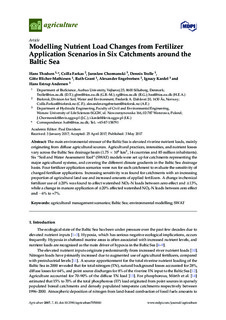| dc.contributor.author | Thodsen, Hans | |
| dc.contributor.author | Farkas, Csilla | |
| dc.contributor.author | Chormanski, Jaroslaw | |
| dc.contributor.author | Trolle, Dennis | |
| dc.contributor.author | Blicher-Mathiesen, Gitte | |
| dc.contributor.author | Grant, Ruth | |
| dc.contributor.author | Engebretsen, Alexander Melvold | |
| dc.contributor.author | Kardel, Ignacy | |
| dc.contributor.author | Andersen, Hans Estrup | |
| dc.coverage.spatial | Baltic Sea | nb_NO |
| dc.date.accessioned | 2018-03-13T14:00:37Z | |
| dc.date.available | 2018-03-13T14:00:37Z | |
| dc.date.created | 2017-11-27T21:12:02Z | |
| dc.date.issued | 2017-05-03 | |
| dc.identifier.citation | Agriculture. 2017, 7 (5), . | nb_NO |
| dc.identifier.issn | 2077-0472 | |
| dc.identifier.uri | http://hdl.handle.net/11250/2490341 | |
| dc.description.abstract | The main environmental stressor of the Baltic Sea is elevated riverine nutrient loads, mainly originating from diffuse agricultural sources. Agricultural practices, intensities, and nutrient losses vary across the Baltic Sea drainage basin (1.75 × 106 km2 , 14 countries and 85 million inhabitants). Six “Soil and Water Assessment Tool” (SWAT) models were set up for catchments representing the major agricultural systems, and covering the different climate gradients in the Baltic Sea drainage basin. Four fertilizer application scenarios were run for each catchment to evaluate the sensitivity of changed fertilizer applications. Increasing sensitivity was found for catchments with an increasing proportion of agricultural land use and increased amounts of applied fertilizers. A change in chemical fertilizer use of ±20% was found to affect watershed NO3-N loads between zero effect and ±13%, while a change in manure application of ±20% affected watershed NO3-N loads between zero effect and −6% to +7%. | nb_NO |
| dc.language.iso | eng | nb_NO |
| dc.publisher | MDPI AG, Basel, Switzerland | nb_NO |
| dc.rights | Navngivelse 4.0 Internasjonal | * |
| dc.rights.uri | http://creativecommons.org/licenses/by/4.0/deed.no | * |
| dc.subject | agricultural management scenarios | nb_NO |
| dc.subject | environmental modelling | nb_NO |
| dc.subject | SWAT | nb_NO |
| dc.title | Modelling nutrient load changes from fertilizer application scenarios in six catchments around the Baltic sea | nb_NO |
| dc.type | Journal article | nb_NO |
| dc.type | Peer reviewed | nb_NO |
| dc.description.version | publishedVersion | nb_NO |
| dc.rights.holder | © 2017 by the authors. Licensee MDPI, Basel, Switzerland. This article is an open access article distributed under the terms and conditions of the Creative Commons Attribution (CC BY) license (http://creativecommons.org/licenses/by/4.0/) | nb_NO |
| dc.source.pagenumber | 17 | nb_NO |
| dc.source.volume | 7 | nb_NO |
| dc.source.journal | Agriculture | nb_NO |
| dc.source.issue | 5 | nb_NO |
| dc.identifier.doi | 10.3390/agriculture7050041 | |
| dc.identifier.cristin | 1519218 | |
| cristin.ispublished | true | |
| cristin.fulltext | original | |
| cristin.qualitycode | 1 | |

